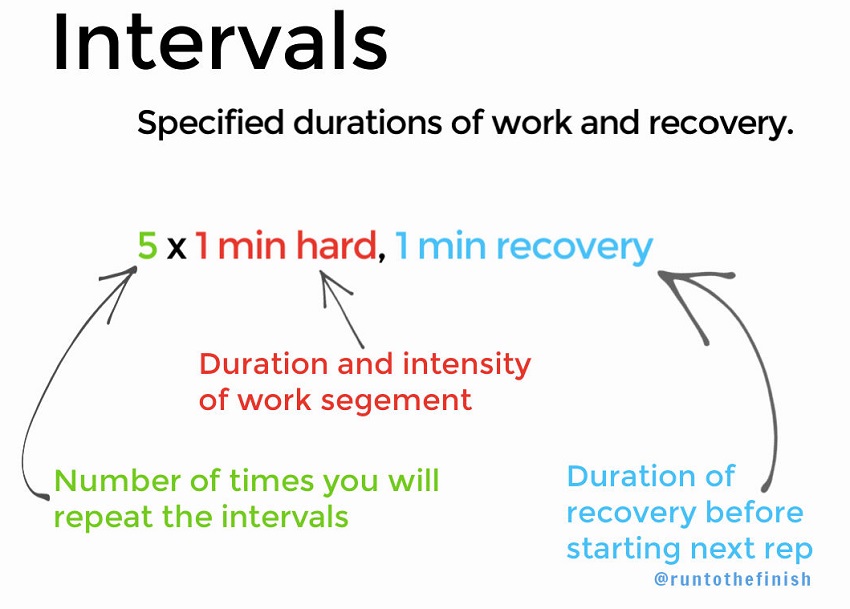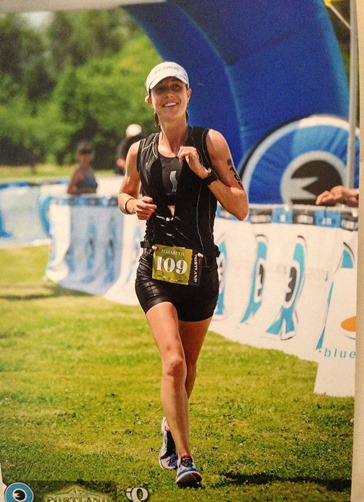Few of you are coming to me with a focus on your one mile pace, so we’re looking at running workouts that are going to test your speed and improve your endurance.
There are tons of ways to incorporate speed training and I hope these ideas will help to bring a little fun to your training, along with improvements.
If you’re wondering why you should incorporate different types of running workouts, or which ones are the most common out there, don’t worry I’ve got you covered!
I’ll be discussing that in this article, as well as giving you 17 different running workouts which include 8 common ones, and 9 that I’ve specially created to spruce things up if you’re used to the common ones.
Want to learn everything there is about running workouts? Then keep on reading!
What are Running Workouts?
A running workout is a structured training session designed to improve your running performance, endurance, speed, or overall fitness.
It typically involves various running exercises and techniques aimed at targeting specific aspects of your running ability. Running workouts can be customized based on your goals, fitness level, and preferences.
Running workouts are a great way to improve your speed and endurance, while also adding variety to your training routine. They can be tailored to any fitness level and goal, allowing you to challenge yourself at the right level.
By including different types of running workouts in your program, you can work on various aspects of running performance such as speed, agility, power, strength, and stamina.

Why Incorporate a Variety of Running Workouts?
Many runners tend to run at the same speed day after day. Running at the exact same effort is a problem because you may not be running easy enough to get the aerobic benefits we want for endurance and yet not hard enough to get the anaerobic benefits of a speed session.
We call that grey zone running.
These types of runs are usually done at a speed that’s 75% of our max efforts, which isn’t fast enough to make our bodies work hard and adapt, but it’s also simultaneously too fast to build considerable endurance or count as a ‘recovery’ run.
It keeps you from becoming stronger and can also increase the risk of injury. In short, our bodies need variety to realize our full potential.
We need really slow runs just as much as we need the really fast runs. This type of variety in running workouts helps work our cardiovascular systems as well as our muscles in different ways. It makes room for not only recovery but also builds strength.
- Your speed workouts should cover a variety of paces
- Even when marathon training it’s beneficial to do 5K and faster paces
- When doing 5K training it’s beneficial to do longer sustained efforts
Keys to A Good Speed Workout
As always, it’s extremely important to remember a few things about running workouts:
- For endurance training this should only be about 20% of your week, the rest should be easy running
- NEVER skip the dynamic warm up, it will lead to injuries with speed workouts
- Learn to run by effort and you’ll always be successful. Because what feels hard some days feels easier on others.
- Even distance runners NEED short speed sessions (check out how a 5k could improve your marathon time)
- Nutrition, nutrition, nutrition – you have to refuel and you have to recover from speed work to get the benefits.
- Learn the etiquette of running track. What lane, common terms, etc.
All right with the ground rules applied, let’s have some fun!
8 Best Running Workouts (For All Types of Runners)
You’ll find that runs are going to fall in to two major categories: easy for endurance conditioning and speed workouts for well building speed.
When you have goals to get faster, you might think more is better, but I can assure you that the opposite is true.
The bulk of your weekly training mileage should be easy runs. We’re talking 80% of your mileage. These runs improve endurance, encourage proper running form, help build consistency, and aid in recovery. An easy run is also sometimes referred to as a base run.
Speed workouts are sprinkled into your training starting with one session per week to allow your body to adapt. Especially if you’re new to speed work, focus on effort in these sessions initially before focusing on distance and specific paces down the road.
Let’s look at 8 of the most important and common running workouts. For each of these workouts, you’ll also find specific ways of doing it based on your current level as a runner.
Make sure to include a warm up with dynamic stretches, running drills and some easy walking then running before any running workout!
1. Easy Run with Strides
Let’s start with the easiest type of running workout: an easy run that finishes with strides. Running at a slow speed increases endurance, encourages proper running form, builds a routine, establishes base mileage, and also aids recovery.
This kind of run should be your most common one, accounting for approximately 65-80% of your total mileage.
Your easy runs should be runs where you stay within heart-rate zones 1 and 2. This is when you can comfortably keep a conversion going and speak in full sentences without running out of breath. That’s why we often call it conversational pace.
When you’re capable of doing that, you’re in your aerobic zone or your ‘easy’ zone. This is where your body and muscles have all the energy and oxygen they need for a run.
For most runners, this is where a majority of your long run miles should be done. Easy runs are also known as recovery runs.
If you’re new to running, start with this type of easy run. Run for 45 minutes at an easy pace. Hitting a certain mileage isn’t important when you’re first starting off, as you’re running for time instead of distance.
At the end of the run throw in 3-5 strides.
Find a flat spot, and pick up your pace for roughly 20 seconds to what you might think of as a sprint, but while keeping your body relaxed. No tensing the face! These are fast pick ups, but while staying relaxed. Walk around for a bit till your breathing is normal and then go again.
DO NOT turn these in to an interval workout. The relaxed nature gives you a chance to run fast, without the recovery needed from intervals.
2. Tempo Run
Tempo runs are an important type of running workout which can help improve your speed and endurance. The pace of the tempo run is sometimes described as “comfortably challenging.”
They are difficult enough to need pushing, yet comfortable enough to allow you to keep going.
This is often approximately 85-90 percent of your maximum heart rate, or slightly slower than your 10K race pace. It’s where brief sentences are doable, but a full-fledged conversation definitely isn’t.
We do tempo sessions to raise our lactate threshold, which is the point at which your body transitions from its aerobic to anaerobic systems and quickly starts to fatigue.
The higher your threshold at a given pace, the longer you can maintain that pace and improve your strength, speed, and endurance.
Sample Workouts:
Newer runners should start with shorter time at tempo. The final listed workout is for advanced runners.
- Easy warm-up miles, 5 minutes at tempo pace, 10 minutes easy, 5 minutes at tempo pace, easy cool down miles
- Easy warm-up miles, 20 minutes at tempo pace, easy cool down miles
- Easy warm-up miles, 20 minutes at tempo pace, 10 minutes easy, 20 minutes at tempo pace, easy cool down miles
Interested in learning more? Checkout What is a tempo run?
3. Hill Workout
Hill workouts are great running workouts that give you many of the same advantages as typical speed exercises without the requirement of running at peak speed.
Running uphill is all about building explosive power, which helps you run faster by promoting speed and use less energy by improving running economy.
On the other hand, running downhill works on your quadriceps while building strength in your tendons and joints.
A well-balanced runner has to be able to handle both uphill and downhill running, which is why you should include both types of workouts while preparing for any type of hilly race (cough Boston).
Sample Workout:
10 minutes easy running
2 x 20 seconds hard effort uphill
— walk down
2x 30 seconds hard effort uphill
— walk down
2 x 60 seconds moderate effort uphill
— walk down
10 minutes easy running
10 minutes at half marathon effort
10 minutes easy running — optional if you feel toast from the hills
Get ideas for more hill workouts and benefits >>
4. Interval Workout
Working on a 5k to 10K race? Then this is your speed training workout!
Interval training consists of brief bursts of fast running followed by periods of low-intensity recovery runs. It involves running or sprinting at the same speed for a set distance and for a set number of times.
It’s all about running high intensities in short bursts. In terms of distance, it can range from 100 meters to a mile, depending on the runner’s fitness level and training goals.

A recovery session should follow this all-out effort, which can be done by running or walking at a lower intensity.
Your aerobic capacity will increase as a result of interval training since it forces you to rapidly adjust to running at a variety of speeds which makes you a more efficient runner.
Running faster than goal pace often shows us we’re able to do more than we think, but also forces us to practice good running cadence.
Sample Workout
10 minutes easy running
4 x 2 minutes at 10K effort
— 1 minute recovery between reps
4 x 1 minute at 5K effort
— 1 minute recovery between reps
4 x 30 seconds at mile effort
— 1 minute recovery between reps
10 minutes easy to finish
5. Ladder Run
If you’re tired of doing classic intervals, the ladder workout variation is a great way to challenge yourself and change things up.
A Ladder Run is a popular interval workout that involves climbing up, down, or both up and down a distance with a brief, typically 60 to 120 second rest break in between each interval.
It’s a great way to push yourself and change things up by running at different speeds and distances at high intensity, all in one workout.
Sample Workout
- Run for 50 meters, then walk for 50 meters
- Run for 100 meters, then walk for 100 meters
- Run for 150 meters, then walk for 150 meters
- Run for 200 meters, then walk for 200 meters
- Run for 250 meters, then walk for 250 meters
These are not the same as ladder drills, which involve using an actual rope ladder on the ground for foot speed.
6. Fartlek Workout
The word “fartlek” in Swedish means “speed play,” which is exactly what the workout is. It’s essentially a chance to experiment with varied speeds and lengths in the same session.
It’s also a great way to get started with speedwork training. It’s perfect for beginners who want to get a taste of speedwork before diving in headfirst.
This sort of speed training is quite simple to perform. Just mix running fast with running slow and vary the distance and pace of each interval.
It might be as simple as sprinting to a random street corner, tree, car, or light post, or running at a tempo rate for three minutes, then an easy pace for four minutes, then a sprint for one minute, and so on.
There are no rules, other than to vary your distances and speeds.
Sample Workouts
Try any of these options on your next run. Remember there is no set recovery, so go 30 seconds or 2 minutes, whatever you need.
- 3 mile run with 5 x 30 seconds hard effort (not max effort!)
- 5 mile run with 10 x 1 minute hard effort
- 6 mile run with 7 x 1 minute increasingly hard effort
Like this idea? Learn more about what are fartlek workouts and how to do them>>
7. Long Run
The long run is exactly what it sounds like: a long run at an easy and steady pace. Long runs are one of the most important workouts of the week. And yes for marathon runners this is part of the intensity in your week.
They boost endurance, form, lung power, and prepare your body for any distance.
Long runs will help you get stronger and show you how far you can go before getting tired. This will give you the confidence to keep going when things get hard during your next race.
They should be done at a natural pace until you are start feeling exhausted.
Sample Workout
Aim to keep your heart rate within 65 to 75 percent of max heart rate. The goal of the long has nothing to do with pace, you can aim to be anywhere from 1 minute to 2 minutes slower than marathon pace.
But the focus of the run is finding an effort level that you can maintain from start to finish which is easy.
8. Track Workout
These workouts are typically done on a running track and involve various speed and endurance exercises, such as 400-meter repeats, 800-meter repeats, or ladder workouts (e.g., running increasing distances at specific intervals).
They provide a controlled environment with measured distances, making it easier to track your progress and push your limits.
Sample Workout
- Run 400 meters (one lap) at a challenging pace, aiming for a consistent effort.
- Take 1-2 minutes of recovery by jogging or walking.
- Repeat this pattern for a total of 4-6 times.

9. Progression Runs
In a progression run, you start out easy and slowly increase your speed over the course of your run and then finish fast. When looking at your mile splits, they should get faster as you go. In this type of run, you don’t have to have set paces you hit each mile.
Benefits of these types of runs include:
- Allowing you to focus on effort levels.
- Provides for a gradual warm up.
- Teaching you to run on tired legs.
- Less stress on the body.
- Teaches you how to finish fast for that race day kick.
A progression run can be formatted in a number of different ways. You might simply get a little bit faster each mile from start to finish. Or you may do 10 miles easy and then pick up the pace for the final 3 miles.
10. Goal Pace Runs
As a more experienced runner, you may have a goal race pace for your next race that will guide you to a personal best or a Boston Qualifying time, for example.
In order to run that pace on race day, it helps to practice running at your goal pace in training occasionally. This lets your body and brain know how it should feel.
You can practice your goal pace during a long run or a moderate-length run during the week. However, it should not be your pace for the entirety of the long run, just certain miles.
You could incorporate this pace in the middle of your run or in a progression-style long run, you would aim to hit this pace toward the last few miles before a cool down.
11. Sprints
All out maximal effort workouts need to be done with the appropriate lead up to them. But once you’ve built a base, we see that even in our masters athletes there are benefits to sprinting!
A true maximal sprint is a pace you can only maintain for probably 10 to maybe 20 seconds! Each repeat has a very long rest and recovery period (2-4 minutes often).
100 meters is one length of a track. That’s a great way to think of the very short distance we’re talking about for a true sprint effort.
Learn all about sprints and how to do them correctly >>

12. Recovery Run
You might be thinking a recovery run is just another easy run in your week, but I can assure it’s different and an important aspect of every distance runner’s training. These runs are meant to help facilitate recovery and are usually done the day after a long effort or hard speed workout.
If you feel like you’re running slow on an easy run day, you’ll want to run even slower in a recovery run, think 1-2 minutes slower than your usual easy pace.
Your main goal is trying to help your body work through soreness, while having the opportunity to get time on your feet, continue developing endurance, and just enjoy running.
These runs should be short too! Think 30 minutes or less.
Remember if you’re previous run has left you completely sore or fatigued that REST is always a good option.
9 Bonus Running Workouts to Change Things Up
Tried all the classic running workouts and looking for some more variations? Here are 7 more running workouts that will help you spruce things up!
1. Climb Down the Ladder
This workout is great for distance runners who need to work on stamina, plus practice running faster. Your goal is to run faster as the distance gets shorter.
Start with 1 round and build up to being able to do 2 rounds.
Take .25 mile easy, easy run to recover between repeats.
1600m (1 mile)
1200m (.75 mile)
800m (.5 mile)
400m (.25 mile)
200m (.12 mile)
2. Stride Goal Pace Sandwich
Strides are a great way to warm up and ease in to faster running or to end a workout.
Start and finish with 5-10 minutes of easy running depending on your current mileage.
3 strides
2 x 9 minutes at goal half marathon pace
— 3 minute recovery between repeats and final strides
5 strides
3. 1 Minute Reps
I love a one minute repeat because it’s short enough that you can mentally talk yourself through it! Try aiming for faster than your 5K pace and hitting the same or slightly faster by the last reps.
Start and finish with 10 minutes of easy running.
10 x 1 minute with 1 minute recovery
New runners start with 6 reps and build up to 10
4. Mile Repeats – A Mental Push
On the flip side of a 1 minute repeat is the mile repeat! This takes a lot of mental effort to find the right pace, settle in and remind yourself that you can hold the pace.
Start and finish with 10 minutes of easy running.
3 x 1 mile at 10K Pace
3 minute recovery jog between miles
Build up to 5 x 1 mile at 10K pace
5. Marathon Effort Plus
When building up to race day, it’s great to practice goal pace running, but first start from where you are! Running workouts aren’t just about going as fast as possible, it’s also about learning how to hold the pace and then push on tired legs.
5-10 minutes easy running
40 minutes at marathon pace (not new goal pace, but previous marathon)
6 x 1 minute fartleks at 5K pace
6. 5K to Full Out
Yes, even marathon runners will benefit from a speed workout that goes to their top end! It reminds you and your legs what’s possible, plus allows you to push in a totally different way.
10 minutes easy running
4 x 3 minutes at 5K effort
3 minute recovery between reps
5 – 10 minutes easy running
3 x 20 seconds all out
walk to bring HR down between reps
7. Long Run Intervals
This speed workout is designed to shake up your long run! While we do many of our long runs at an easy pace, if you build in some speed to certain long runs it’s a chance to mentally feel even more prepared for what race day will bring.
10 minutes easy running
4 x 3 miles at goal marathon pace
5 minutes easy running between miles
10 minutes easy running
8. HIIT Workouts
For my runners who love a good Orange Theory session, I have actually created an entire list of Running HIIT Workouts you can do on your own! These are a great way to really change up training.
As always, a reminder that not every run should be intense. It’s why training plans include easy days, rest days and faster pace runs. You need them all to be a strong, healthy runner.
And there you have it!!
A wide variety of ways to play with speed during your training to help build speed and endurance.
9. Pyramid Track Workout
This workout involves gradually increasing and then decreasing the distance of the intervals. It challenges your speed and endurance while allowing for recovery periods.
Run 200 meters (half lap) at a moderate pace.
Take a 30-60 second recovery.
Run 400 meters (one lap) at a slightly faster pace.
Take a 60-90 second recovery.
Run 800 meters (two laps) at a challenging pace.
Take a 90-second to 2-minute recovery.
Run 400 meters (one lap) at a slightly faster pace.
Take a 60-90 second recovery.
Run 200 meters (half lap) at a moderate pace.
Take a 30-60 second recovery.
How to Incorporate All Types of Running Workouts?
Hopefully you have a better understanding of the different types of runs and their benefits. Now it’s time to start incorporating them into your training.
Remember, you don’t need to do each type every week. There aren’t even enough days in the week for you to do that! But depending on your upcoming race and your goals, start sprinkling the appropriate run types throughout your training period.
This is why it becomes really important to follow a well structured training plan or work with a running coach.
- training plan will rotate you through different types of running
- a smart coach will progress your reps or intensity based on how your body is responding
- those new to these types of runs should stick to one per week
- experienced runners can benefit from adding two types (i.e. intervals on Tuesday and progression long run on Saturday)
Less is more. Easy runs should always be the bulk of your training mileage. And remember big improvements are about consistency, not a single type of running.
Here are some training plans to get you started:
Other ways to connect with Amanda
Instagram Daily Fun: RunToTheFinish
Facebook Community Chatter: RunToTheFinish
Sign Up to Receive a Weekly Newsletter with Top Running Tips and Laughs
